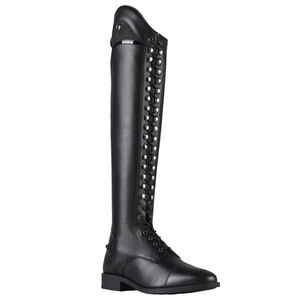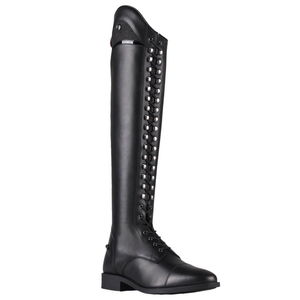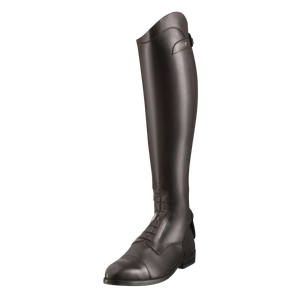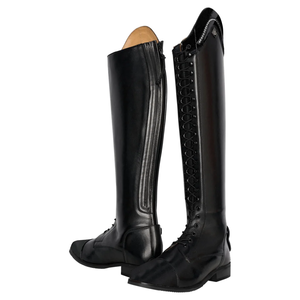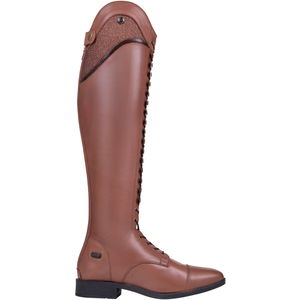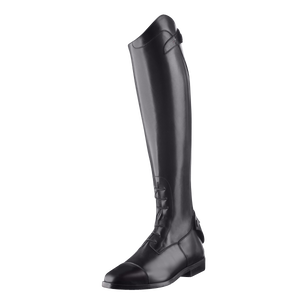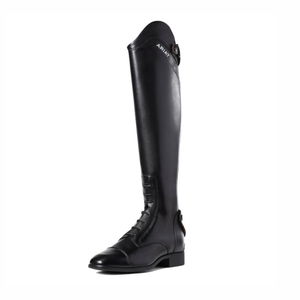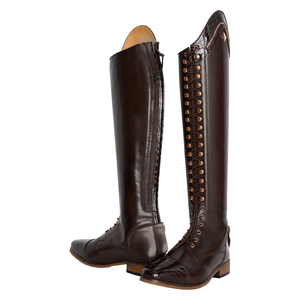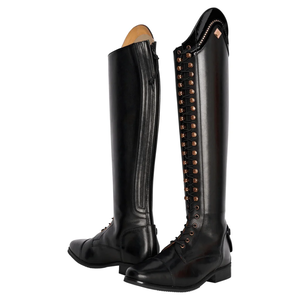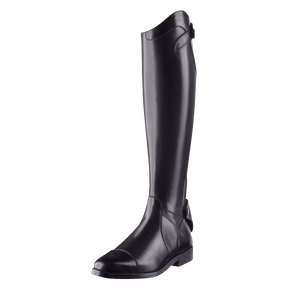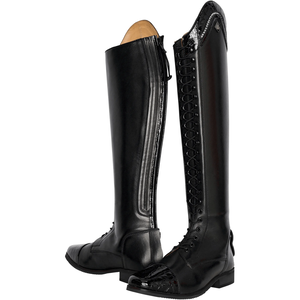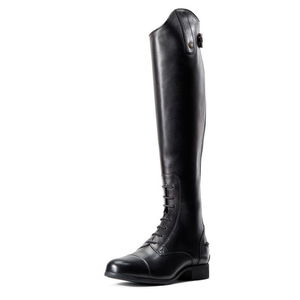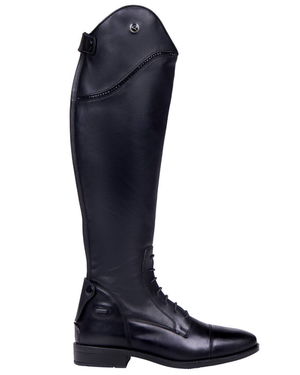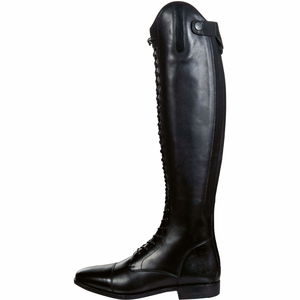Riding Boots (90)
Everybody who rides horses needs riding boots, and these are available in various models and designs. It is important that the equestrian boots fit... LEARN MORE
Frequently asked questions about Riding Boots
Wearing riding boots has quite pragmatic reasons. Their shape and texture make the riding boots perfect for the requirements of the equestrian sport. The primary purpose of a riding boot is to prevent the foot from slipping through the stirrup. Therefore, each boot has a small block-stacked heel, which ideally equals the lowest point of the leg. Only the point located at the ball of the foot exerts pressure on the stirrup, which makes the sole particularly strong and slip-resistant at this point. Another important factor is the material of the boot. There are now boots made from special rubber mixtures, fabric chaps or even vegan innovations from recycled fruit waste. However, leather remains the standard as a tried and tested material. When riding, friction occurs between the calves and the saddle and also between the horse's belly and the saddle. Leather is very durable, hard-wearing and therefore gentle on the underlying fabrics, as well as on the skin. Another important point is stability. Depending on the model, this can vary greatly, but unlike riding with just ankle boots, a proper riding boot provides increased support and thus ensures a steadier leg.
All riders have to find the best brand or model for themselves, a process that can sometimes take years or even a lifetime. The variety of riding boots is huge, since there are now not only the classic off-the-peg models, but also individual unique pieces, such as custom-made riding boots, which can be individually customised both in design and in their leather type. In many cases, it is not even necessary to have them made to measure, because off-the-peg boots or even a partial customisation can also be considered. In this case, you benefit from quick availability and somewhat lower prices. It is recommended to try out the different models and brands to find the right boot for you.
Riding boots are made of various types of leather, but calf leather, which is used very often, is more expensive than the coarser box leather. Appliqués made of stingray leather, patent leather, ostrich leather or rhinestones increase the price accordingly. At the top of the price range for riding boots are the full-size boots of leading brands. For these, the entire foot is measured and an individually fitting boot is created based on the measurements. This does not necessarily mean that expensive boots are the better ones, but you should not compromise on quality in terms of durability. Riding boots have to withstand a lot in the saddle as well as in the stable, since sweat, dirt and friction can take their toll on the leather as well as the closures.
Basically, there are three categories amongst boot manufacturers. On the one hand, there are dressage boots that have a stiffened outer bootleg, a raised dressage arch and an internal zip. On the other hand, there are jumping boots that follow every movement over the jump due to their soft texture, the low arch and the comfortable way they are worn. Finally, there are polo boots, which are often offered with a front zip or complete lacing. Depending on the discipline, requirements and preferences, you can make a choice. Dressage boots create a steadier and more stable leg and look elegant at the same time, but a dressage boot will never be as comfortable in breaking in as a soft, well-fitting jumping boot. As you can see, at the end of the day you are spoilt for choice. It is not uncommon for riders to have several pairs of boots so that they don't have to commit to just one type when buying.
Riding boots should fit snugly and ideally form a movement fold at the ankle. Depending on the leather, this takes 1-2 cm off the height of the boots. This must be considered when buying, as otherwise the boot cannot close in the hollow of the knee. Apart from that, you should make sure that the riding boots do not suppress the feeling of the leg too much. This often happens when the bootleg is too tight or when there is too much space between the material and the leg. Finding boots that fit perfectly can be a difficult task. Although they should fit snugly, they should also never be so tight that they cut off the legs, which makes them uncomfortable to wear.
As so often, this question cannot be generalised. Depending on the use, quality and maintenance, riding boots can be companions for several years or only for a short period of time. This argument becomes clear as soon as you consider how differently riding boots are made. Dressage boots, for example, are stiffened on the outer leg, which makes the leather less vulnerable than in soft jumping boots. Another point of wear concerns the zips of the boots, which is why there are now more and more lace-up boots that eliminate the problem of tiring zips. Proper cleaning and maintenance, as well as appropriate handling of the riding boots, usually prolong their durability considerably.
Riding boots can quickly become too tight at the leg, which often does not even require a large increase in weight. In summer alone, or towards the evening, the legs tend to swell minimally, which can lead to a loss of fit in otherwise perfectly fitting boots. But if the riding boots pinch and squeeze in the long run, you should consider having them stretched. For this purpose, you can send the boots on request to an experienced cobbler or a specialist. For a fee, the riding boots can be individually adjusted without having to buy a new pair.
Beginners often wear cheaper models, as buying riding boots is an expensive affair and at the beginning of the riding career it is not always clear whether the sport will be pursued further. Riding boots made of rubber or leather ankle boots with chaps or bootlegs are an inexpensive alternative for starters. If, in the course of time, a passion for riding is developed, the purchase of riding boots can be considered. At first, the somewhat softer and cheaper models that fall under the category of jumping boots are sufficient.
For children, the issue of buying riding boots is more difficult. This is because children grow steadily, which means that the boots may no longer fit after just a few months. For this reason, it is advisable to buy rubber riding boots or a combination of ankle boots with chaps / leather legs for children. These are much cheaper to buy and can be replaced more quickly and cheaply once the children have outgrown them. Depending on the riding level and the use, the transition to leather riding boots should be made early enough, as these create a better feeling in the leg and ensure an optimal fit due to their material.
Most riders use riding boots all year round. Still, there are also winter riding boots that are equipped with a soft lining. However, the visual appearance of such boots should be taken into account, as the cosy, warm lining makes the boots look wider. These kind of boots always guarantee warm legs, as the lining is usually made of thick wool.
Finding the right size for riding boots is similar to shopping in a big shoe shop. Each brand has different variations in size, as the materials often differ and the manufacturers therefore produce different sizing charts. You can find the measurement charts of the different manufacturers on the respective manufacturer's website or in the online shop. If you measure your own foot and calf correctly, there is not much that can go wrong when it comes to finding the right size. If you want to be absolutely sure, you should have the measurements taken by a specialist retailer in the vicinity or by a second person.
Optimal care results from just a few components. Basically, cleaning with water and a soft cloth or sponge is sufficient. If the manufacturer of the boots supplies products, their use is indispensable. In addition, the boots can be treated occasionally with shoe polish. Another important point is the storage of the boots. It is highly recommended to use boot stretchers. These keep the boots in shape and ensure that they last longer. If the boots get very dirty or wet, they should be cleaned with a soft brush to remove the mud and should then be placed upright with boot stretchers to dry.
With the countless brands and models on the market, it often helps to get advice on the spot in a specialist shop or on the phone from the retailer. However, there are always people or legs that fall through the industry's cracks because their proportions are unusual. For example, women with strong calves and narrow ankles usually have a hard time finding a boot that fits, because most boots are produced with different standard measurements. But even if no off-the-peg boot fits and your wallet won't allow for a fully customised boot, there is still the possibility of getting a partial customised boot to fit you.
It is strongly discouraged to grease riding boots. The purpose of greasing leather is to keep it smooth, soft and nourished with leather soap after cleaning. This may be necessary for saddles or snaffles to maintain the durability and suppleness of the leather. With riding boots, however, this is an absolute no-no. To leather boots, the motto "less is more" applies! In fact, cleaning your boots with leather soap and leather grease will damage them. This is because greasing the boots softens the leather, which causes them to lose their shape more quickly and increases the strain on them. Therefore, you should simply clean them with water and polish them with shoe polish. This is perfectly sufficient for your expensive footwear. If the boots do get very dirty or wet, they should be cleaned with a soft brush to remove the mud and should be placed upright so that they can dry with boot stretchers.
Just like widening, tightening the riding boots is no problem. Depending on where and how much leather has to be removed, the professionals decide for themselves whether the change is ultimately possible in the specific case. One problem is the somewhat longer waiting time for the boots, which can sometimes extend to several weeks. Depending on your requirements, it might be preferable to buy a new pair of boots that fit better from the start.
Riding boots guidebook
Riding boots are one of the rider's most important pieces of equipment, as they provide pleasant comfort as well as safety. Therefore, you should not settle for any compromises during the selection process. Instead, you should place great value on quality. Consult this guidebook to find out what to look for when buying high-quality, durable riding boots.
Why should I wear riding boots?
Unlike ordinary shoes, horse riding boots provide high protection during equestrian sports. The full-length sole prevents the rider from getting caught in the stirrups in the event of a fall. The integrated heels also help keep the rider from slipping out of the stirrups during riding. This is very important during jumping and dressage
How should riding boots fit?
When you buy a riding boot, it should fit so that the end of the shaft is under your kneecap and/or in the hollow of your knee. This will feel uncomfortable at first. But keep in mind that the boots’ leather will take some time to settle. This means that the riding boots will shrink by up to two centimetres. Once they shrink, however, they will fit your legs perfectly and feels comfortable. This settling usually takes about two months in the case of soft leather types, while harder varieties can require up to half a year.
To calculate shaft length and calf circumference, it's best to perform your measurements in the evening. You should also wear riding breeches and riding socks, so you do your measurements accurately. It’s also important to apply the measuring tape properly and loosely.
A riding boot is a perfect fit if it does not pinch your calf and is not too loose. You must be able to move without feeling like you are going to slip out of the boot.
Make sure the boot doesn’t rub in the foot area.
Tip: The shaft heights and dimensions vary between the manufacturers. So you must always pay attention to the particular manufacturer's specifications in this regard.
How much do riding boots cost?
Affordable, commercially available models without add-ons or extras typically cost about 30 Euros. However, these are products that do little to captivate the customer, from the point of view of workmanship and the materials used in their manufacture. If you believe quality matters, you should anticipate spending between approximately 250 and 750 Euros for your riding boots. Here, you have the choice between riding boots with laces and riding boots without laces.
Then again, you can go for ankle boots as an alternative. These are available starting at about 100 Euros. Nevertheless, ankle boots are only suitable for the summer, and they don’t provide any especial comfort for the rider.
What characterizes a good pair of riding boots?
When you are looking for new riding boots, you should attach particular importance to the following factors:
- Quality
The products available vary significantly in terms of materials and workmanship. Make sure that the material is glued or, better yet, stitched in top-notch fashion. The crossovers must be cleanly processed. Likewise, don't settle for any compromises when it comes to the selection of materials. High-quality leather shoes offer a real advantage here, as they make for a comfortable fit and your feet perspire significantly less than they do wearing riding shoes manufactured from rubber, for example.
- Functionality
Good riding boots stand out due to their broad functionality. First, you have to determine your individual needs. Do you need riding shoes for the summer? Leather riding boots for the winter? Or dressage boots, then? Do you prefer riding boots with laces? The opportunities vary considerably, so you should buy the shoes in accordance with their intended purpose. Thermo boots, for example, are suitable for the winter, since they are equipped with a special inner lining that keeps your feet warm. Dressage boots, meanwhile, are meant to provide the rider the best possible grip on the horse.
- Comfort
Especially if you find yourself riding your horse rather often, comfort plays a decisive role. Your riding boots shouldn’t pinch, but they shouldn’t be too big, either. They should provide good breathability and keep out damp. Above all, though, they should fit comfortably, even after you’ve been wearing them for many hours.
- Design
Design is not a decisive factor, though it is an important criterion for many riders. Women's riding boots, in particular, should not only be functional and comfortable, but should also look attractive, to delight women's hearts.
Caring for your riding boots: it's important!
To guarantee your riding boots a long useful life, you should clean and care for them according to their needs. Leather products require special care to prevent damaging this valuable material during cleaning. Please consider the following tips:
- Don't use any brushes
- If heavily soiled, you can use a soft cloth to clean the shoes by hand using lukewarm water. Tip: If you encounter horse manure on the riding boots, remove this immediately to prevent aggressive acids, etc. from attacking the leather.
- Next, dry the boots off completely with a cloth and leave them to dry in the open air for at least a day. It is important never to leave riding boots to dry on the heater or radiator, since this will cause the moisture in the boot to dry out, and the boot will become brittle.
- In the case of coated leather boots or products made from patent leather, no further steps need to be taken.
- If you wear riding boots equipped with so-called “adhesive leather”, then you should refrain from using any care products. This would destroy its adhesive properties and eventually cause a significant loss of functionality.
- If you want to use additional care products, be sure to pay attention to the manufacturer's directions and only use cleaning products recommended by the manufacturer
Tip: Zip closures are best cleaned using a small, soft brush.
Which riding boots do we sell?
We value high quality, which is reflected in our offer of riding boots. Our range currently includes products from the following manufacturers:
- Animo riding boots
- Ariat riding boots
- Ego7 riding boots
- Kerbl riding boots
- Parlanti riding boots
- QHP riding boots
- Sergio Grasso riding boots
- Tonics riding boots
- Tucci riding boots
Conclusion
Whether you're looking to buy jumping boots, stall shoes, winter riding boots, rubber riding boots, horse riding boots with laces, riding boots kids or leather riding boots, always keep an eye out for excellent quality and fit.

